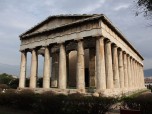The Parthenon is an Ancient Greek temple in Athens. It stands on the Acropolis and remains largely intact. This makes it one of the most important monuments of its day to have survived. Built in the fifth century BC, the Parthenon has been employed in a variety of uses. At various times the parthenon has been utilized as a church, fortress, and mosque. It is now one of the most commonly visited tourist attractions in Greece.
Early History
The impetus for the building of the Parthenon came with the destruction of an older temple by the Persians. The prominent Athenian politician Pericles was the driving force behind the construction of the new temple, which was intended to house a statue of the goddess Athena. The statue was 40 feet tall, and was he product of the sculptor Phidias, with Kallikrates and Iktinos acting as the projects main architects. A number of the Acropolis’s other significant buildings, such as the Propylaia, were also erected in this period.
Most of the building work on the temple took place between 447 and 438 BC, although some decorative work continued for at least another five years. The most expensive aspect of the project was the transport of marble from Mount Pentelicus, ten miles from the city. By the time the Parthenon was finished, the treasury of the Delian league had established itself at the Acropolis, having moved from Delos.
The Parthenon kept its place as the center of Ancient Greek worship for almost a millennium, and it was still in regular use in the 300’s AD. One of the later emperors took the statue of Athena in the fifth century and carried it off to Constantinople. It is believed to have been destroyed in 1204 when Constantinople was sacked by crusaders.
Medieval Times
At some point during the Middle Ages, the temple became a place of Christian worship. To facilitate its use as a church, certain modifications were made to the structure, including the removal of some internal walls and columns and the installation of an apse. A number of statues, particularly those showing gods of pagan Greece, were destroyed, possibly deliberately. The basic structure of the building, however, was allowed to remain largely intact, with visitors reporting that the temple retained its previous characteristics.
When forces of the Ottoman Empire captured Athens in 1456 the Parthenon became a mosque. At this time a minaret was added. The building itself was left largely intact for two centuries until an assault on the city by the Venetians in 1687. The defending Ottomans used the building as a fortress, making it a prime target for the attackers. In September of 1687, a powder magazine was hit by a shell from Venetian guns and considerable destruction was caused. The roof fell in completely and several pillars were badly damaged.
Modern History
Athens became increasingly popular with European visitors during the 18th century. The semi-ruined Parthenon inspired a number of French and British visitors to support independence for Greece. In 1801, the Earl of Elgin, the British ambassador to the Ottoman Empire, was granted permission by the Sultan to view antiquities, and to demolish modern buildings if necessary. He was extremely assiduous in this task, going so far as to buy some sculptures from Athenians themselves, as well as prising a number of intact examples off the Parthenon.
The sculptures he removed have become the object of considerable controversy in modern times. They are held at the British Museum in London, and are generally known in Britain as the Elgin Marbles. The Greek government strongly objects to their continued absence from Greece, and insists that the items should be returned to their homeland.
In 1832, after victory in its war of independence, Greece gained full autonomy from the Ottomans, and therefore control of Athens. At this time the Parthenon was stripped of its minaret. Likewise, many buildings on the Acropolis dating from the medieval period or later were demolished. The national government declared the area a historical precinct. In more recent times, owing to concerns about damage from the huge numbers of visitors who come to the site each year, a fence has been put up around the temple in order to maintain the integrity of its structure.
Facts
The Parthenon is not the most complete temple of its type in Athens. That honor goes to the Temple of Hephaestus, which stands close by. The Parthenon is, however, generally considered the most impressive temple in the region. Constructed in the Doric style, the temple stands on a platform, known as a stylobate, which is slightly curved in order to maximize the impression of grandeur. The columns themselves also display a slight bulge, producing an optical illusion which fools the eye into thinking that the Parthenon is perfectly symmetrical.
The temple’s base measures around 230 by 100 feet, supporting what was once the the inner chamber of the temple, or cella. Each of the exterior columns stands more than 30 feet in height, with a diameter of about six feet. The columns in each corner are a little thicker, also by design. In ancient times, the temple carried a large amount of intricate decoration, mostly in the form of sculptures of marble. Only parts of these decorations have survived. It is known that the pediment on the eastern flank contained a large sculpture with a representation of Athena’s birth.
On the western flank, the main decoration was of Poseidon battling with Athena for Attica. Additionally, each side of the Parthenon displayed friezes, which also depicted battle scenes from Greek mythology. The internal cella decoration, which is now lost, is known to have contained both a display of the Greek gods and a huge multi-sided frieze showing the Panathenaia festival, which honored Athena. Although the temple’s marble is now almost pure white, this was not the case originally. In fact, the exterior statues were brightly painted, while the ceilings of the internal rooms were blue.





















